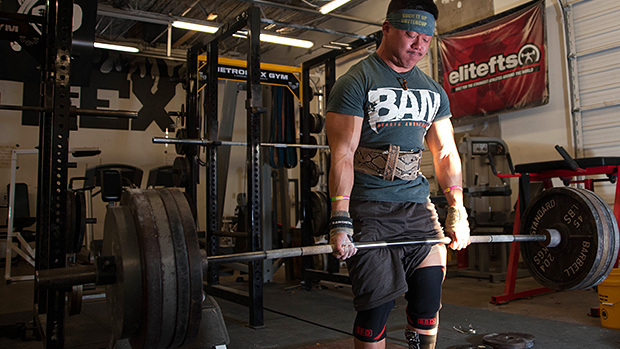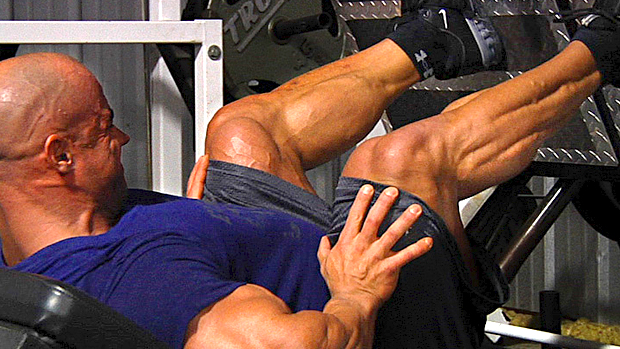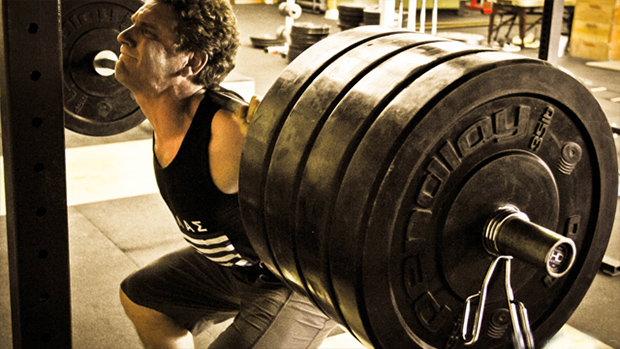Over the past few years I've seen many lifters and coaches discussing the seemingly strange movements I prescribe for strength development. Many of these guys are grasping the big picture but missing many of the finer points. To remedy this, I've written this "toolbox" series to help experienced lifters fill in the blanks and newer lifters learn about some very effective exercises.
You'll notice that many of the movements in this toolbox are "assistance" or "accessory" exercises designed to assist the big lifts: squat, deadlift and bench press. This all goes back to a fundamental truth in strength training: to get stronger, a lifter must discover his weak points, then work to bring them up. These exercises will do just that!
Reverse Cable Side Bends
- Category: Supplemental and Accessory
- Muscles Targeted: Abdominals and Obliques
- Exercise Description: The movement is performed on your standard lat machine with the use of a single D-handle. This is one of the best movements I've found to target the muscles of the obliques in a very unique way.
You begin by standing with your side to the machine. Grab the D-handle and pull it down to your side so your arm is locked straight to the side. From here perform the same movement as you would a one-arm dumbbell side bend. The difference with this is the resistance is now opposite what it would be with dumbbells. The tension is now on the downward phase.
Before you begin, tighten your abdominals and obliques. Now bend to the side and make sure to keep a controlled tempo. Flex your obliques very hard when you reach the midpoint and keep your upper body erect. Return to the start position slowly while keeping as much tension on the obliques as you can.

When you complete the set you'll then switch sides. I've found this movement works very well when performed two ways. The first way is to train very heavy for 6-8 reps. Another method that seems to work very well is to keep the weight light for sets in the 30-60 second range.
Training Mistakes
- Going too heavy. This may cause you to break form and begin to bend forward.
- Using too fast of a training tempo. Keep the tempo slow and controlled, making sure to keep tension on the muscle.
Dimel Deadlifts
- Category: Supplemental and Accessory
- Muscles Targeted: Hamstrings and Lower Back
- Exercise Description: This exercise helped Matt Dimel increase his squat from the mid-800's to over 1000 pounds in a two year period. To perform this exercise, grab a barbell with an overhand grip, hands about shoulder-width apart. Pull the bar up to a standing position.

At this point, arch your back and get your abs tight. Keep the back as arched as possible, push the glutes out, and keep the knees slightly bent. Lower the bar by pushing your body weight back onto your heals while pushing your glutes out. Try to lower the barbell to a position just past the knees. At this point you should feel a tremendous stretch in the glutes and hamstrings.
Raise by contracting your glutes first. At the top of the movement, contract the glutes as hard as possible. Perform the exercise in a ballistic fashion. You want to drop to the midpoint position and explode back to the starting position. This is best trained with moderate weight for sets of 15-20 reps.
Training Mistakes
- Going too low. Make sure to keep the tension on the hamstrings.
- Not pushing the hips and glutes back. This is also to keep the stress on the hamstrings.
- Rounding the back. Keep your back arched to help keep the stress on the hamstrings.
- Using a slow tempo. This movement is designed to be trained fast. You'll begin with a slow tempo and build the speed up with each additional repetition.
Rainbows
- Category: Supplemental and Accessory
- Muscles Targeted: Torso
- Exercise Description: This exercise is designed to isolate the obliques. To begin, lie on your back with your hands over your head holding onto a heavy object. Pull both knees toward your chest in a tucked position. Keeping this tucked position, roll your knees to the left side until they touch the floor, then rotate back to the center and finally to the right.

You must keep your shoulder blades on the floor. If you want to increase the difficulty, perform the same movement with your legs straight.
Training Mistakes
- Letting your shoulder break the floor. Keep your shoulders on the floor even if it means you won't be able to reach a full range of motion.
Cambered Bar Box Squats
- Category: Max Effort
- Muscles Targeted: Hamstrings, Lower Back, Hips and Quads
- Exercise Description: The cambered squat bar is an excellent variation to a straight bar for several reasons. First, because of the camber of the bar, there's more stress on your posterior chain and less on your upper back. Because your hands are near your waist when squatting, it's very difficult to squeeze your upper back. This will force you to keep your middle and upper back arched.

Second, the cambered squat bar is great to relieve stress on your shoulders. With a straight bar, your shoulders are held statically in an external rotation. This stress can be grueling for a larger lifter and those wishing to increase their bench press.
Finally, the cambered squat bar requires you to remain extremely tight when you squat. This is because the weight tends to swing forward and back when lifting. The box height can vary when using this bar: below parallel, parallel, or several inches above. A close to medium stance is used when using the cambered squat on max effort day.
Training Mistakes
- Rocking on the box. Sit solid, pause for one second, and squat up.
Chain Suspended Push-Ups with Blast Straps
- Category: Supplemental and Accessory
- Muscles Targeted: Chest, Shoulders, Triceps
- Exercise Description: This movement is performed by setting up Blast Straps around the top of a power rack or other stable object. You can set the handles as close or far away from the floor as you'd like. The closer to the floor, the harder the movement will be.
I've found it best to set the straps 4-6 inches off the floor. With this set-up you'll be able to get a very deep stretch and increase the range of motion, something you can't do with a barbell or a standard push-up.

Grab the handles and set your body up in a standard push-up position. Make sure your torso is rigid; don't allow your lower back to sag or raise your glutes in the air. Strive to keep your shoulders, hips and knees in a straight line. If you have difficulty maintaining this position, you can perform the push-ups while on your knees. This is often caused by a lack of ab and low back strength. (I often use the suspended push-up position to access core strength in athletes.)
To increase the difficulty of this exercise, try placing your feet on an elevated surface or a stability ball. Placing an exercise band behind your back is another great way to make this exercise more challenging. I've also found that using a variety of hand and elbow positions during your sets allows for great versatility.
Training Mistakes
- Rounding your back. This should be common sense, but I see it all the time. Keep your damn back straight.
- Not using a full range of motion. One reason for the straps is to allow you to go deep. Note: If you have shoulder problems or it hurts to go too low, then be smart, don't do it!
- Setting the straps too high. Unless you're pathetic and can't do a push-up, then drop the straps down close to the floor.
Abdominal Fall Out with Blast Straps
- Category: Supplemental and Accessory
- Muscles Targeted: Obliques and Abdominals
- Exercise Description: Begin this exercise in the same position as the suspended push-up. With a slight bend in your elbows, raise your hands over your head. Again, only go as low as you feel comfortable. Your goal should be to have your hands, shoulders, hips and knees in a straight line.

The motion is very similar to an ab wheel but even more difficult! Think of it as a jacked-up abdominal wheel. This exercise is great for your abs, shoulders and lats. When you lower yourself, be sure to stay tight and to lower slowly.
Training Mistakes
- Rounding your back at the bottom. Keep your back straight and abs tight at the bottom.
- Forcing it. Just go as far as you can. You'll get stronger in time; there's no need to force what's not there.
Rice Digs
- Category: Supplemental and Accessory
- Muscles Targeted: Fingers and Forearms
- Exercise Description: This is really a very simple movement. Get a big bucket and fill it with rice. I've also seen rubber chips, metal shot and sand used. The metal shot is hardcore and should only be used by those with a very strong grip to begin with. Rice is your best bet as it's the easiest to use and you can always progress up to the sand from there.

I made mine with a big laundry tub I found at the dollar store and a huge bag of rice from Sam's club. Once you get it set up all you do is dig your hands in and begin squeezing. Pretty simple stuff, nothing too complicated.
I've also found I get great results when I twist my wrists both clockwise and counterclockwise as I squeeze. This is best done to failure at the end of your training session, so get digging!
Where Do I Get This Stuff, Dave?
I understand that many of these movements may require equipment you don't have. I'm not using this as a sales pitch (well, maybe a little bit!), but I'd be a fool to not tell you that you can get all of these items at www.elitefts.com.
The thing is that many of the movements we do require different types of equipment. With these articles I'm trying to blend a mix of movements you can do with and without the use of special equipment. I'm including all items because there's a large number of you who do have this equipment and may not be using them to the best of your ability.
Until next time, keep training hard, bring up your weak points, and set some damn PR's!




